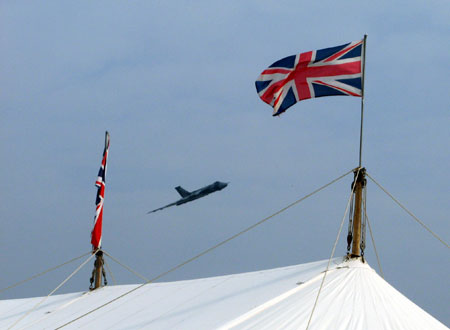
If we want to understand how people connect to the past through material culture, then the British phenomenon of 'Goodwood Revival' offers an unparalleled opportunity to explore that relationship. For three days in September thousands of people (over 130,000 in 2009) go to a motor-racing track in Sussex to celebrate and re-create what is often called the 'golden era of motor sport' through races and displays of historic cars.[1] But Goodwood Revival is also certainly Britain's (and arguably the world's) largest historical re-enactment. First held in 1998, Goodwood Revival has become not only a major venue for racing historical cars, but also a remarkable phenomenon reflecting popular attitudes towards changes in British society, the whole expressed through participants' relationships with material culture, and especially cars and clothing.
Since its emergence as a pastime in North America 50-odd years ago, through Colonial Williamsburg and the American Civil War centenary of the early 1960s, and British and European re-creations of every period between imperial Rome and the Second World War, historical re-enactment has become a fruitful medium for exploring ways of understanding the past by participating in reliving it. Typically, re-enactors are male and inclined to the military. Civilian 'living history' re-enactors remain a minority. Vikings and Napoleonic grenadiers seem to be its habitual denizens, with women largely relegated to auxiliary roles as 'camp-followers'. Re-enactors tend to be enthusiasts, often spending large amounts of money, time and energy on their hobby.[2]
Their pastime, long an area of academic interest in the United States, has recently become the subject of scholarship in Australia, not least through the efforts of several Australian scholars.[3] Their various experiences of re-enactment (encouraging in the case of Stephen Gapps; less so in that of Iain McCalman) have given impetus to the investigation of the phenomenon. Most recently, McCalman and Paul Pickering have argued in their book, Historical Re-enactment: From Realism to the Affective Turn, that re-enactment's vogue, in both popular and academic ventures, derives from its ability to meet a need for emotional understanding as well as provide intellectual insights — what they term the 'affective turn'.[4] Their recent interpretation of the significance of re-enactment as a way of understanding the past provides a framework for this discussion, which (coincidentally and independently) amplifies their approach. Despite Goodwood Revival's scale and (as I will argue) the way it expresses an emotional relationship to the past and, even more, the present, it appears to have so far evaded scrutiny.
Goodwood Revival departs from the familiar model of male-oriented, seriously-researched, military-inspired, hobby-based re-enactment. Its participants largely re-create the civilian. They comprise men and women in more-or-less equal proportions, and they do so for a few playful days, many of them returning annually. Goodwood Revival fits imperfectly into the analytical categories hitherto identified: 'house' (as in the BBC's The 1900 House), 'pageant' (as in re-enacting particular events or ceremonies such as Captain Cook claiming New South Wales on Possession Island in 1770), 'theatre' (more scripted displays, such as the playlets performed at, say, Sovereign Hill outdoor heritage museum in Victoria) and 'real' (as in the popular restaging of historical combat).[5] Goodwood Revival fits into none of these categories exactly. It may be a variety of 'pageant' re-enactment, albeit of the most diffuse kind: a historically-related 'happening' rather than a structured event. But it embodies exactly the 'affective turn' — the engagement with the emotions — that McCalman and Pickering identify as one of the most powerful impulses bearing upon the re-creation and re-enactment of the past. Most importantly (for reCollections), the material culture of the past, in clothing and in machinery, remains central to participants' interest and involvement in Goodwood Revival. The event justifies scrutiny. A carnival of motor racing and dressing up suggests and evokes deeper interpretations of both the past and the present.
Goodwood, near Chichester in West Sussex, part of the estates of the Earls of March, has been known as the location of a horseracing track since about 1800. In 1948 the family built a motor-racing circuit, based on the perimeter road of the wartime Royal Air Force Westhampnett station. It became one of the premier tracks for events under the auspices of the British Automobile Racing Club. Goodwood closed as a motor-racing track in 1966. Thirty-odd years later Charles, the entrepreneurial present Earl of March, revived the course as a venue for racing historic cars. Integral to this celebration of the grand days of British motor sport was the idea that spectators should contribute to and participate in the desired historical ambience by dressing in period costume relevant to the cars that race at Goodwood; and so was born Goodwood Revival.
Running it as a highly successful business venture, the organisers sell tickets in advance. All are sold out months before the event. The core of the meeting is the enthusiasts who own, maintain and race historic motor cars manufactured between the late 1920s and the 1950s. In 2009 the event featured a race for Mini Minors, celebrating 50 years of the type. The displays and races in turn attract spectators, many of whom appear to have no strong interest in cars, but who are drawn by the idea of being part of a gigantic historical pageant.
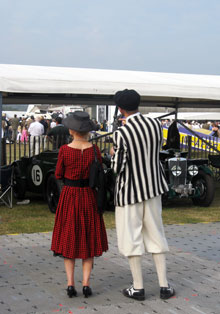
Now in its twelfth year, the 2009 event attracted over 360 vehicles, all built or used in the period 1930–66, and present at the personal invitation of the Earl. The number, range and rarity of historic vehicles on display in the Paddock were extraordinary. They included, for example, all four of the Le Mans-conquering Aston Martin DBR4s, each worth well over £1 million, and 18 of the 17 British inter-war racing cars, the ERAs ('18 out of 17', because under the rules governing the re-creation of historic racing cars one, wrecked in an accident, became the basis of two rebuilt vehicles). Rare or famous vehicles, such as Ferrari GTOs and Daytona Cobras, line up with cars once driven by racing heroes such as Jim Clark and Tazio Nuvolari — machines normally seen only in museums. Though the vehicles invited to appear at Goodwood are often restored and maintained to standards comparable with museums, many are also entered in highly competitive — and therefore inherently dangerous — races. Despite the risks, Goodwood Revival confirms the adage that the best way to preserve heritage is to use it.
Historical motor-racing journalist Gordon Cruickshank sought to explain to me the nature of the phenomenon:
People argue about which was motor racing's 'Golden Age'. It's now! We have all the finest cars ever built racing for us, often driven by the greatest drivers. It's the equivalent of cricket fans being able to watch W.G. Grace and Jack Hobbs and Gary Sobers again, while wearing waistcoats and cravats. And we're all guests of His Lordship.[6]Goodwood Revival combines various attractions, but at its centre (literally and aurally) are the races and, in 2009, 16 races were held through the weekend, for various classes and types of historic vehicles, including motorcycles, and sports and racing cars. In addition, hundreds of vehicles, racing and non-racing, are on display, and visitors inspect them, knowledgeably chatting to their owners and mechanics. The conservation and maintenance of these vehicles is generally of museum standard, regulated by the British Automobile Racing Club and affiliated bodies and sustained by a vast industry encompassing literature and manuals, spare parts and restoration services.
Such is the drawing power of Goodwood that world champions of motor racing like Jackie Stewart, Damon Hill, Jack Brabham and John Surtees look forward to invitations to attend, some to race cars they drove decades before. In 2009, to mark the 80th birthday of the legendary British driver Sir Stirling Moss, organisers were able to mount a parade of no fewer than 80 cars associated with him. These included the BMW 328, which he first raced in 1937, the Cooper-JAP Mark II, which he first raced at Goodwood in 1948, the Cooper-Climax T53 'lowline', which he drove to victory in Formula 1 races in Australia and New Zealand in 1961, and the Keele Kart go-cart which he raced on an impulse and won in 1959. The parade suggests both the veneration that Moss attracts among racing enthusiasts — spectators treated the electric buggy that carried him about the event much as devout Catholics regard the Popemobile — but also the enthusiasts' devotion to the material evidence of Moss's career.
Few of the details generously and abundantly supplied by motor-racing enthusiasts have stuck in my brain. I do not share their passion, but I recognise and respect it. It became clear that the core of Goodwood Revival is the profound dedication to the veneration and celebration of historic racing cars, by preserving, restoring and using them. Strolling about the Paddock demonstrated that historic motor sport enthusiasts possess a powerful grasp of the vital connection between historical knowledge and historical material. Even when some of these vehicles were replicas (again, permissible under the British Automobile Racing Club's rules), often the replicas were themselves not only facsimiles of vehicles that had been unique or produced in very short runs; in one case the only replica of a car of which only one model had ever been made. In short, the participants' respect for the material artefacts of their passion makes Goodwood a supreme celebration of the value of the preserved reality of motoring.
The weekend now also features an air display, which in 2009 included over 30 historic aircraft. These were mostly static displays but included flights by aircraft such as Messerschmitt Me 109; two de Havilland Dragon Rapides; Spitfires, Hurricanes and a Lancaster of the Royal Air Force's Battle of Britain flight; a replica of a Vickers Vimy (of the kind flown by Ross and Keith Smith to Australia in 1919); and the only flying Avro Vulcan, the Cold War 'V-bomber'. Again, the effort demonstrated the collectors' passion to maintain and use historic aircraft in the face of the challenges of keeping an aircraft in flying condition. The huge Vulcan bomber — the only aircraft to win a round of applause after a series of noisy low-level passes across the airfield adjoining the Paddock — cost £7 million to restore and over a million a year to fly.
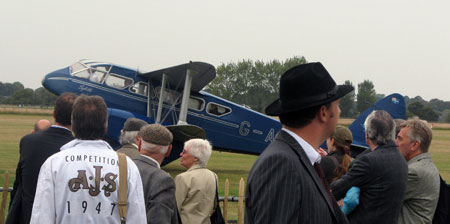
These are hobbies largely the preserve of the wealthy: historic vehicles valued in millions stood in rows in the Paddock. Motoring journalists in the know calculated that the rare and beautiful cars occupying the starting grid for Goodwood's headline race, the TT, totalled £56 million, much more than the worth of any Formula One grid. But Goodwood Revival is more than merely a place for rich rev-heads to show off or race their expensive hobby cars and planes. Participants are visibly middle class and ethnically English — they are far from the youthful enthusiasts attracted to, say, Canberra's annual Summernats car festival, with its notorious devotion to burn-outs, wet T-shirt competitions, beer and fast-food.[7] A large proportion of Goodwood participants neither own nor race cars, and many are clearly not connoisseurs of cars. Indeed, many do not watch the races at all: the grandstands and track-side viewing areas accommodate a fraction of those attending, and at any time the static exhibits, trade stalls, food areas and paths between them hold many more people than does the race-track. For those interested in understanding the links between material culture and historical interpretation, then, the real interest in and significance of Goodwood Revival lies in the way in which its participants appear, behave, think and feel, and that reveals a deeper set of motivations and relationships.
But all relate to history. An awareness of, or attitude towards, the past is central to Goodwood Revival's popularity. The official Goodwood Revival website describes the event as 'a magical step back in time', an opportunity to spend a weekend in 'the romantic time capsule of the Fifties and Sixties'.[8] The Revival, another motoring website claims, 'closes the gates on the modern world'.[9] Clearly Goodwood is about more than mere machines: it expresses and embodies popular attitudes towards the past.
The Goodwood Revival's sartorial aspect has become increasingly important. The event is promoted as an opportunity to enter into a relationship with the past, principally by wearing historical costume. The official Goodwood Revival website makes clear that participants are expected to take dress seriously, to participate 'in sympathy with the period theme'.[10] A huge market area caters to the tastes of clothing as well as motoring buffs. Visitors move between these areas constantly, entertained by parties of actors (as we will see) and by musicians performing around the many refreshment venues. Every aspect is closely programmed by the event's organisers, and all are required to harmonise with its intended period ambience. The continuous, spontaneous, unstructured behaviour of costumed participants exactly meets the definition of 'things experienced and felt' that Iain McCalman identifies in his 2007 History Council of New South Wales lecture, where he discusses historical re-enactments and asks, 'Should we take them seriously?'[11]
Some participants combine an interest in clothes and cars, including those re-creating the uniforms and the vehicles of the Automobile Association. Even team mechanics are required to wear white overalls and to maintain a consistent and supposedly authentic appearance. Many enter into the spirit of the event with enthusiasm. Participating members of the public are strongly encouraged to dress 'appropriately'. Men are supposedly forbidden from entering the Paddock without a jacket and tie, and are urged to wear a suitable hat; women are encouraged to wear at least a frock and hat, and even gloves and handbag if possible. The Earl of March lets it be known that mobile phones are discouraged from being used in the Paddock (though no such proscription is made towards modern cameras; nor could such a ban be enforced).
I attended Goodwood Revival in 2009 because I happened to be arriving in London on the first day of the three-day event, which Gordon Cruickshank was to cover as deputy editor of Motorsport magazine, Britain's premier journal of historic motor racing. Gordon thought I might enjoy the ambience of the Revival, and invited me to join him as a guest. Accepting his invitation confronted me with a dilemma as to my own costume. Synthetic fabrics post-dating the mid-1960s are severely discouraged, but the website offers many suggestions, such as hiring military uniforms from the Second World War. My first thought, to borrow a contemporary military uniform from a collector friend, came to nothing. Complicated by having to go to Goodwood practically straight off a plane from Sydney, I decided that hiring a costume in Britain would be impractical, as would hiring a costume in Australia and returning it by post. What I regarded as an inspiration — wearing my old school uniform, whose crushed condition would only add to the style I sought — wife and daughters vetoed as impossibly nerdy. (On arrival I saw at least two men who had evidently not been saved by their family's advice, and I had to admit that short trousers were indeed a mistake.) In the end I found that a nondescript tweed jacket, woollen tie and shirt and trousers of natural fibre and bland hue made me indistinguishable from a good proportion of male visitors of my age.
Thus kitted out, with a borrowed 'Press' armband (in period-looking brown card tied on with string), over two days I mingled with the crowd and marvelled at the phenomenon that is Goodwood Revival. At first merely curious, I became intrigued by the relationship between the clothing people adopted and the historical understanding such apparel seems to embody. My encounter was largely subjective, anecdotal and impressionistic, but it suggests at least the value of the event as a window into popular historical understanding of a slice of British society in 2009.
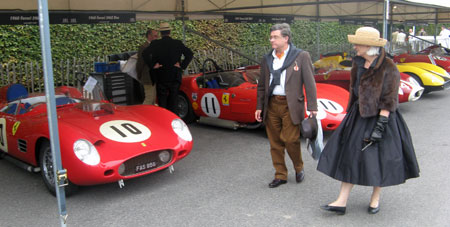
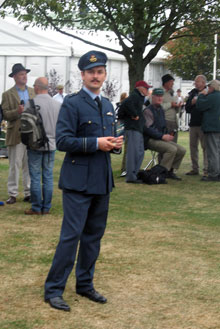
Participants' choices of costume emphasise the centrality of the Second World War to the event. Among men the single most popular uniform was that of the Royal Air Force (the third day of the event coincided with Battle of Britain Sunday, the annual commemoration of the RAF's defeat of the Luftwaffe's attempt to subdue Britain from the air in 1940). While many simply wore an RAF uniform of some kind, some achieved a striking accuracy in dress (complete with rank badges, medal ribbons and, for some devotees, handlebar moustaches, whether fake or real). Another substantial group affected American air force or army uniforms, with British army uniforms a poor third, although often well executed. (A trio of re-enactors sporting the shorts, turbans and tans of the Long-Range Desert Group strode about earnestly, seemingly in search of their lost Jeeps; an effect spoiled by everything, including their kit, being brand, spanking new.) Uniformed men's partners often wore either a corresponding civilian dress or the uniform of the relevant women's service. Except for a few WRAF and WRENS uniforms, relatively few women chose specifically wartime service uniforms, with the exception of some Land Army 'girls' and a few of what might be called the Rosy-the-Riveter look: civilian war-workers.
This evocation of wartime dress seems to be crucial in understanding of the event's political-historical significance. The 1940s, and especially the Second World War, matter to Britons today — much more than they do to, say, Australians. (In Britain it is still often referred to as 'the war', even with several contenders for that title, including one very visibly occurring in Afghanistan.) Though the Second World War strictly falls outside the period that the Revival nominally seeks to re-create, it remains the most dominant historical presence at the event. Not only are some of the aircraft some of the most well-known aircraft of the war, many of the site's facilities (such as several cafes) explicitly echo wartime themes. Clearly the discrepancies between the periods of cars, aircraft and clothing do not bother participants — many presumably do not distinguish precisely between decades — and 'the war' remains predominant.
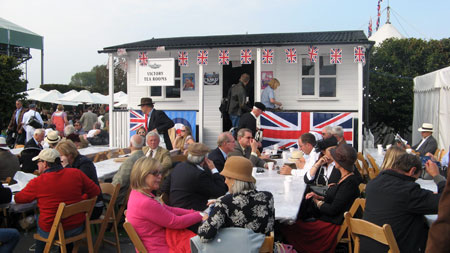
The setting was sometimes in the Midlands, sometimes in Kent, but with a G[reat] W[estern] R[ailway] station that would have been on the west of England lines; hairstyles were a joke, skirts too long.[13]
And so on. The point is not that the BBC's usually meticulous production designers and script editors slipped up; it is that significant numbers of viewers know and care about the clothes, hair, look and language of the period.
Why is this so? It would not be possible for any other period in British history. Certainly societies such as the Sealed Knot can draw on several thousand members (overwhelmingly male) to re-enact aspects of the English Civil War, and while medieval 'living history' groups present 'fairs' or 'tournaments' at various English Heritage events, all are the province of more-or-less committed hobbyists. (The annual Bristol Medieval Fair, for example, though probably drawing more spectators than Goodwood Revival, has many fewer costumed participants, almost all members of dedicated groups.) Goodwood Revival appears to be the only event that draws a mass-costumed participation from the general public. The reason for this is arguably that it meets a widespread popular need to interpret recent British history in a particular way — and therefore in fact to express a view of contemporary Britain.
It is accepted that 'nostalgia' is one of the several reasons for the appeal of re-enactment. Historical editor Paul Eggert has identified the growth from the 1960s of a 'democratised worship of the past, and often the recent past'.[14] Eggert connects the rise of this generalised nostalgia with 'the decade of the screening of Brideshead Revisited', a BBC television series set between the 1920s and the Second World War, 'which rendered nostalgia almost a communicable disease'.[15] Goodwood Revival's re-enactors are deeply infected. The whiff of nostalgia pervades Goodwood, mingling with the smells of exhaust and fried food. Vivienne Kelly, in an article in History Australia, quotes the American scholar Jay Anderson's suggestion that re-enactors' motives include a curiosity about the nature of everyday life in a particular historical period and 'a nostalgic preference for the past — usually a particular epoch'.[16] Goodwood's weekend re-enactors exhibit no philosophical concern for the workings of time in the abstract, nor do many embody the obsessive concern for the nature of everyday experience — they do not insist on (for example) absolutely authentic shoes or underwear. Near-enough is good enough for the great majority. But dismissing re-enactors as merely seeking to assuage a 'nostalgic impulse' or acting out 'parody or pastiche' is, as Iain McCalman argues, insufficient explanation. He answers his question about re-enactors ('Should we take them seriously?') in the affirmative. He grasps that re-enactment, even in an informal, pleasure-seeking fashion, expresses a relationship between past and present. Likewise, British columnist AA Gill captured it in an account of recreational shooting (a sport also conducive to dressing up) in which he speculated on the British attachment to 'role-playing nostalgia'. 'If you dress up in the clothes of the past', he writes in Previous Convictions, 'then in some way you're taking part in a practical sense in something that communes with the past'.[18] Goodwood Revival's participants demonstrate a strong emotional attachment to the period surrounding the Second World War, and it is this that makes Goodwood Revival so pertinent to those interested in what material history signifies.
The Second World War is central to Goodwood Revival's success. While its cars generally do not have a strong connection to the war years (because civil car production virtually ceased in wartime), Second World War aircraft are prominent in its aviation displays. Even more, wartime uniforms and dress suggest that the Second World War is the most identifiable period in participants' minds. The war's significance can be seen in some of the static displays mounted, including a simulated Ministry of Food information tent and what was billed as 'The Real Dad's Army'.
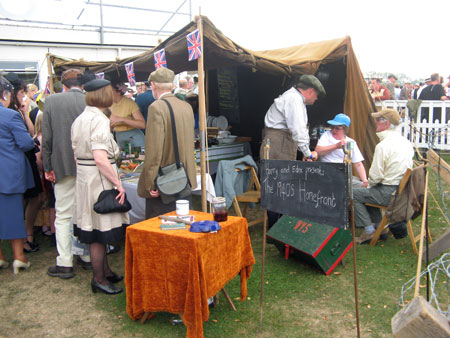
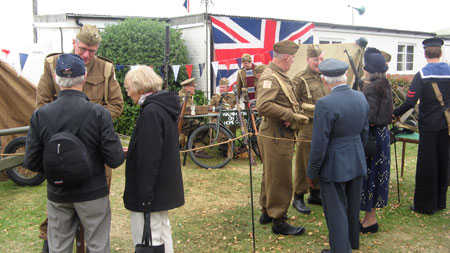
The Real Dad's Army attracted a steady stream of the curious, many eager to chat with its members, who took turns of duty at the rope barricade. (Were they sharing memories of the war, or of watching some of the 80 episodes of the popular program?) Nor are the re-enactors the only manifestation of the fascination with the Second World War. A Dad's Army Appreciation Society has some 1700 members, while the village of Thetford, Norfolk, where the series was mostly filmed, has opened a Dad's Army Museum. European Union funding has even provided support for a Dad's Army Heritage Trail around the area.[22] That the group impersonated fictional characters from a gentle farce set in wartime Britain highlights the place of fantasy in the sort of historical understanding that Goodwood Revival represents. In essence, then, Goodwood Revival expresses a popular desire to evade what has become known as 'broken Britain'.[23]
Conservative columnists have of course long fulminated at what they see as declining social standards and behaviour. Digby Anderson's thesis (as summarised by a somewhat sceptical Charles Moore) might be representative. Anderson argues that:
'Middle England' has committed suicide. There used to be an English bourgeoisie who valued 'orderliness, decency, modesty, reticence, amateurishness, deferment of gratification, moderate religion, saving, small shops and speaking properly. They were proud of their country and its history.'Now, Anderson argues, middle-class Britons:
ape 'the lower classes' in dress and accent. They slump over their food and pick it off one another's plates. When they are quite old, they dress grotesquely young. They object to the referee in sport, shop on impulse and talk about sex loudly at the hairdresser's.Anderson wistfully hopes that a 'long and horrific war' might bring a return to standards, but doubts it. The self-consciously genteel behaviour of most participants at Goodwood Revival — many wearing the clothes evoking Britain's last major war — explicitly refutes Anderson's strictures.A search of blogs and websites, both broadly conservative and libertarian, elicits a mass of concern about social issues such as 'sink estates', inadequate parenting, poor diets, the absence of courtesy and civility, 'lads' and 'ladettes' and public binge drinking, youth sub-cultures such as 'Chavs' or 'Neds', violence (especially growing gun- and knife-crime), vandalism, graffiti, 'dogging', 'crusties' and 'travellers', young people on (or breaking) 'Anti-Social Behaviour Orders' (ASBOs). A sample of this vast informal commentary suggests that the tenor of concern about changes in British society extends beyond the conservative party and press.
Let's see, what else happened in the UK [in October 2009]. Millionaire footballer 'punched woman and broke her nose after she rejected his advances'; Off-duty PC left fighting for his life after horrific assault by mob of homophobic teenage thugs; Gang 'set fire to man's beard as he slept on train'; Teenager killed widow with axe in drink-fuelled rage after losing a computer game to his brother Female prison officer quits after 'affair with murderer'; Bouncers stand guard at WWI memorial urinated on by drunken student Cancer survivor beaten unconscious in unprovoked attack [but] I see knife crime is dropping off.[25]Gerry Hassan, writing on the left-wing website Compass (offering 'Directions for the Democratic Left') recently claimed that, 'like it or not the phrase and ideas behind "Broken Britain" capture something about the extent of the anxiety, fear and stress that many people have about modern Britain'.[26]
'We're letting in too many people. We're an island, for God's sake. And the Britishness seems to have gawwwnnne.' She enunciates the word 'gone' so poshly that it takes a while to work out what she's saying She talks of a nation of bullies and paedophiles in which people live in fear.[27]
Goodwood Revival seems to offer Britons a way to escape from or even actively resist or contest the idea of a 'broken Britain', and one expression of this feeling can be seen in the costume adopted by its participants. Indeed, it is arguable that Goodwood Revival represents a conscious rejection of the features of 'broken Britain' by explicitly embracing the costume of a period seen to contrast with the problematic present.
The proportion of participants at Goodwood Revival adopting some form of historical dress strongly suggests that their adoption of historical costume is purposeful. Spot counts (of numbers of costumed and un-costumed participants passing a particular point for given periods) suggested that between 60 and 75 per cent took the trouble to dress up. (On Friday the percentage seemed higher, presumably because only the keenest were inclined to take a day off work. On Saturday the event seemed to attract many mainly interested in cars rather than costume, but even then at least half of all participants dressed in period costume.) Goodwood Revival offers a muted version of the 'period rush' sought by more rigorous re-enactors. Not for its tweed-suited and twin-setted participants the discomfort of girdles, rough serge or stiff-soled shoes. They eat the fancy British stodge (sausage and onions and bacon-and-eggs but also anachronistic burgers and baguettes), and as much cappuccino or soy latté seems to be drunk as sweetened white tea. But the lack of obsessive detail fades in the face of mass desire to capture a mood or feeling of the past.
Under the cover of my 'Press' armband, I approached a number of participants to discover more of the dress they had chosen and why. Their responses illuminated the political dimensions of a seemingly innocent day of dressing up.
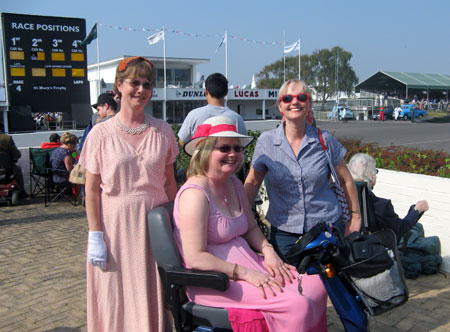
While waiting for the Mini race to begin I asked three spectators what had attracted them to Goodwood. We had time for a lengthy chat — a dramatic oil leak from the Mini driven by Prince Leopold von Bayern caused a long delay, a feature of motor racing not usually highlighted in the glamour press. The sisters, from Middlesex, Hertfordshire and Bedfordshire, had come on a family outing. They had taken particular care over their ensembles, even though one had been in hospital for months, having recently lost both legs. They had bought their dresses in charity shops and matched accessories to family jewellery, and one had adopted the dress of a 1950s teenager, in checked shirt and jeans. All had taken part in Goodwood Revival before, one as part of the Police Historical Association's displays of historic police vehicles, another because a former partner had competed in races. But they continue to come, despite health problems, not just because it allows them to enjoy time together as sisters, but also because the event enables them to spend time in 'another world', one in which 'dressing up' conjures up values and attitudes quite different to those of contemporary Britain. It was an idea I was to hear repeated with variations through the day.
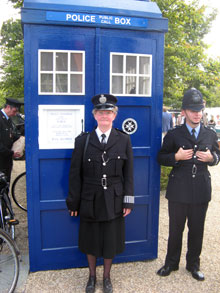
Just down the ramp from the track was an area given over to a display of a dozen or so historic police vehicles, including a Wolseley, described as the last surviving vehicle used in the Coronation — the Queen's State Coach excepted, I suppose. Standing by a replica of a police call box was June, wearing the uniform of a Woman Police Constable of the Monmouth Constabulary, circa 1966. June had been attending Goodwood Revival for eight years, drawn into historical re-creation while restoring her Triumph Herald as a Panda car of the Monmouth force. She had built up an authentic police uniform, complete to hard-to-find regulation shoes and even period glasses. Unlike most Goodwood Revival participants, she and her friends resembled the serious (and usually military-oriented) historical re-enactor. In thick woollen uniforms, worn regardless of the warm day, they presented a contrast to their contemporary real-life counterparts, dressed in high-visibility jackets and weighed down with crowd-control kits. June found that people responded to the police re-enactors much as they had to policemen and women in the days before police adopted weapons, respecting the authority of their uniform and seeking help from them as if they were real police. The crowds, who jammed the paths and walkways between exhibits, arguably behaved more congenially and good-naturedly than do other British crowds today, with public drunkenness and offensive behaviour virtually absent. Introducing another commonplace in conversations about the event, June also talked about how participants' costumes projected 'old-fashioned' values, of how their uniforms became triggers for reminiscences of people's childhood or the lives of their parents.
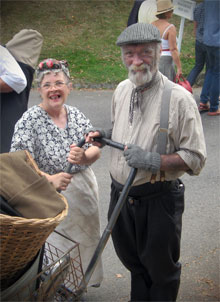
Two people stood out from the Goodwood Revival crowd. They were dressed not as glamorous figures, but as a rag-and-bone man and his wife, a character she described as Mrs Mop, from the popular 1940s BBC wireless program, It's That Man Again! Dressed in dirty work clothes and in a floral overall and turban, they marched about pushing an old upright pram loaded with salvageable junk. These were Ron and Val Anderson, members of the Revival's own troupe of professional actors, many of whom return year after year, refining their act. The essence of Ron and Val's turn was that in the personas of a cockney rag-and-bone man and a charlady they had permission to initiate and respond to banter from the crowds. While people typically participated in the Revival in groups of friends, in the characteristic manner of modern crowds most people did not know or engage with their fellow participants. Ron and Val broke this communal silence, introducing into the crowd a suggestion of the 'mateyness' supposedly representative of an earlier, more innocent age, when strangers might well have struck up conversations. The choice of a pair able to chat —distinguished from suit-and pearl-wearing middle-class participants — represented a clever connection between Ron and Val's physical appearance and the need to foster a feeling of 'togetherness' supposedly characteristic of Britain 60-odd years ago.
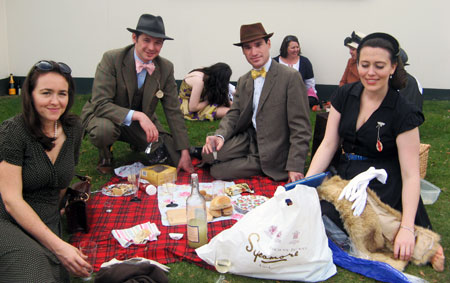
I encountered four young professionals from North London — two couples, barristers or civil servants — picnicking. They had participated in Goodwood Revival at least once before, and had returned wearing splendid and authentic-looking outfits that they had taken care to assemble over the preceding year. They had bought some items at vintage stalls and drawn on hand-me-downs from within their families. All had entered into the spirit of the occasion, though their picnic was more 2009 healthy gourmet pâté and cheese rather than period dried-egg and meat paste sandwiches. Why had they returned to Goodwood? I asked. Their replies suggested the political significance of a seemingly innocent epicurean picnic. They talked about enjoying re-creating a time when society was 'more civilised', 'good-natured' and 'polite'. They enjoyed the formality of clothing quite different to their usual recreational dress (the men pointing out that they wore collars-and-ties to work anyway) but liked the atmosphere of civilised enjoyment that Goodwood Revival represented. I asked if they were conscious of assuming or projecting a class identity by their choice of clothing. On the contrary, they replied, the formality of the dress of 50-or-so years before was, they thought, less class-based — virtually every man wore a tie. These Islington professionals seemed to be consciously seeking to connect with a romantic fantasy of British life — a good-natured populace, untroubled by class division, able to enjoy a pleasant sunny day's recreation without care.
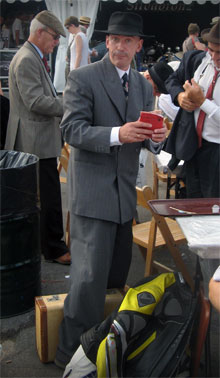
Goodwood's troupe of actors includes 'Tony the Spiv', another long-standing character at the Revival. 'Tony' plays the part of a wartime 'spiv', a small-time racketeer who could, like Private Joe Walker from Dad's Army, obtain food, clothing or petrol 'off the ration', for a consideration. The doubtful legality of the spiv's dealings gave Tony full licence to importune members of the public, offering forged ration books and coupons and other goods, probably stolen. Tony's reflections on the event echoed others I had spoken to. He found that people, especially those who were also in costume, were willing to enter into the theatre suggested by his role. He also found that while people over 40 recognised the part he was playing (from either their own or family memory), younger people often lacked any historical reference to shortages, rationing and the black market and thought that he was just a small-time con-man (and sometimes even an actual con-man). Tony's part, which he played with great verve, even at the end of what had been a long and warm day, suggests the fragility of historical reference in popular memory. Perhaps to succeed on a popular level historical re-enactment needs a clear period reference and recognisable characters, often reinforced by popular entertainment (the generic Hollywood gangster, say, rather than anything too subtle or historically specific such as the Spiv, who requires a sort of basic social historical framework in order to be read). Even in a society as knowledgeable of, even preoccupied with 'the war' as Britain, that reference knowledge is a diminishing resource.
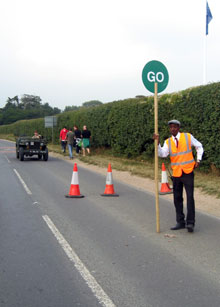
Though it offers an often thrilling and sometimes beautiful display of historical motoring and aviation technology, Goodwood Revival is only ostensibly about cars and aircraft. Its participants' devotion to re-creating the costumes and even the customs of the recent past suggests that in their eyes it expresses a particular view of contemporary Britain. Is it significant, for example, that among the thousands of participants I saw only one black face — and that was of a worker paid to control traffic on the site's approach roads? Perhaps the period the Revival celebrates has no special resonance for families whose own memories of that time do not involve pearls, plus-fours, Bentleys or Spitfires. Equally, though (Dame Shirley Bassey's views notwithstanding), most black Britons do not generally share family memories of this period in Britain. Lacking the cultural reference that fuels their nostalgia, black Britons remain remote from what Goodwood celebrates.
Goodwood Revival could be dismissed as — to quote Iain McCalman again — 'the present dressed in funny clothes'. But he does not believe that re-enactment should be disdained, and neither should we. Goodwood Revival embodies two (possibly paradoxical) views of the past and its objects. First, it demonstrates that large numbers of people value the material culture of the past — in the case of the machinery, by lavishing vast amounts of money and energy in preserving and operating it. Second, it shows the intimate relationship between the past and the present, expressed by Goodwood Revival's participants using the past's material culture — its clothing, or a rough approximation of it — to make a judgement about the present.
Even a cursory encounter with Goodwood Revival offers a productive field for speculations on the power of material culture to arouse and inspire on a mass scale. It evokes pleasantly nostalgic memories of what is perceived as a more genteel time, one with many resonances for family memory. But Goodwood also expresses a political interpretation of history, one no less powerful for being inchoate rather than explicit, representing to participants a time when Britain was supposedly not 'broken'. Those feelings, memories and ideas are expressed and represented primarily by the power of material culture. The mass popular re-enactment of Goodwood Revival powerfully endorses the argument that re-enactment is primarily about the 'affective' in linking the past and the present.
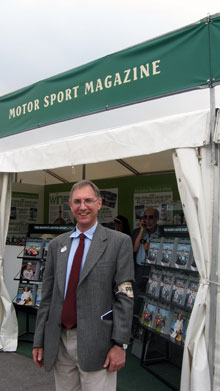
This article is a product of 'Material Histories', a collaborative project of the Centre for Historical Research, National Museum of Australia, investigating the relationship between material collections and culture and the understanding of history.
1 A Google search on the combination of 'golden age of motor sport' and 'Goodwood Revival' elicits over 300 references.
2 In Australia, re-enactment has largely been the preserve of amateurs, who mainly re-create war (42 of the 45 groups under the Queensland Living History Federation relate to wars, from the Roman Empire to the Vietnam War). 'Living History' enthusiasts — devoted to practising and preserving old trades and civilian callings — constitute a minority.
3 Academic studies have been undertaken, mainly by Stephen Gapps, a principal of the consultancy Historica (see www.historica.com.au/aboutus) and Vivienne Kelly, whose article 'Ghosts of the past: Breaker Morant and re-enactment' (History Australia, vol. 6, no. 1, 8.1–8.14), reflects on re-enactment through three re-enactments of Morant's trial.
4 Iain McCalman & Paul Pickering, (eds), Historical Re-enactment: From Realism to the Affective Turn, Palgrave Macmillan, Basingstoke, 2010; see the introduction, pp. 1–17 especially.
5 ibid., p. 7, citing Jonathan Lamb, The Evolution of Sympathy in the Long Eighteenth Century, Pickering & Chatto, London, 2009, p. 137.
6 Gordon Cruickshank to Peter Stanley, 5 January 2010.
7 I largely finished drafting this article during Canberra's annual Summernats fesival, and was able to make a clear comparison with the look and sound of Goodwood Revival. Though equally noisy, the two could not be more different. Summernats looks to the present and the new, with speed and performance the only determinants of modifications to cars. Goodwood explicitly looks to the past, and imposes strict rules relating to authenticity in modifying and maintaining historic vehicles.
8 Goodwood Revival website consulted 13 November 2009.
9 Airtrack Motorsport website, www.airtrack.co.uk/motorsport/Goodwood-Revival-Travel-Tours-Hotels-Accommodation-Tickets.asp?sube=85&cat=4, consulted 5 January 2010.
10 See the Goodwood Revival website, www.goodwood.co.uk/site/content/revival/Getting-the-Look_Welcome.aspx, consulted 5 January 2010.
11 Iain McCalman, Historical Re-enactments: Should We Take Them Seriously?, History Council of NSW, Sydney, 2007, p. 7.
12 Nor are these the only such series. Of television dramas we might notice Brideshead Revisited (for the 1920s and 1930s), the revived series of A Family at War, All Creatures Great and Small, Dr Finlay's Casebook, Enemy at the Door, Housewife, 49, Licking Hitler, We'll Meet Again, Wish Me Luck; or among comedies 'Allo 'Allo!, Goodnight Sweetheart, or It Ain't 'alf 'ot, Mum. In films, Asylum, Atonement, Dance with a Stranger,Enigma, Gosford Park, Iris, Mrs Henderson Presents, Shadowlands, Vera Drake; and so on.
13 'Media Monkey', Guardian, 28 September 2009.
14 Paul Eggert, 'Witnessing social history: The artefact, the visitor and the new museology', reCollections: Journal of the National Museum of Australia, vol. 3, no. 2, October 2008, 101–22 (p. 108).
15 ibid., p. 109.
16 Jay Anderson, Time machines: The world of living history, quoted in Kelly, 'Ghosts of the past' (p. 8.9).
17 McCalman, Historical Re-enactments, pp. 13–14.
18 AA Gill, Previous Convictions: Assignments from Here and There, Simon & Schuster Paperbacks, New York, 2006, p. 61.
19 Home Front Friends website, www.homefrontfriends.org.uk/index.html, consulted 13 November 2009.
20 See www.therealdadsarmy.co.uk, consulted 9 December 2009.
21 See, for example, Tony Horwitz's Confederates in the Attic: Dispatches from the Unfinished Civil War (Hodder Headline, Sydney, 2000), that popularised the re-enactor jargon 'farb', meaning one insufficiently dedicated to authenticity, and described with wit and insight in Tim Moore's I Believe in Yesterday: My Adventures in Living History (Jonathan Cape, London, 2008).
22 www.explorethetford.co.uk/trail_details.aspx?ID=1, consulted 9 December 2009.
23 'David Cameron: Together we will mend broken Britain', Metro [newspaper], 8 October 2009; www.metro.co.uk, consulted 16 October 2009.
24 Charles Moore, 'What's wrong with Britain? Less than the Jeremiahs allow', Daily Telegraph, 15 May 2004; www.telegraph.co.uk/comment/personal-view/3606002/Whats-wrong-with-Britain-Less-than-the-Jeremiahs-allow.html, consulted 5 January 2010.
25 www.theawl.com/2009/10/drunk-chick-represents-everything-wrong-with-britain, consulted 5 January 2010.
26 www.compassonline.org.uk/news/filter.asp?t=524, consulted 13 January 2010.
27 Simon Hattenstone, 'Bassey is back', Guardian Magazine, 24 October 2009, http://www.guardian.co.uk/music/2009/oct/24/shirley-bassey-interview, consulted 13 November 2009.
